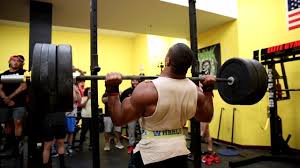The Strict Overhead Press is one of the rawest expressions of upper body strength. Although not as complete as the Bench Press in activating the entire upper body — and lower body — the overhead press can really test your mettle.
But when you’ve stalled in gaining strength on the strict overhead press, apart from rethinking your rep schemes and deloading, there are certain exercises you can do to power through.
Get Strong on The Overhead Press

The overhead press itself may be difficult to progress linearly since the muscles it primarily tasks are relatively small — anterior deltoids and triceps. The bench press, for example, necessitates strength in the anterior deltoid, triceps, upper back, and pectorals. This means that more upper body muscles directly contribute toward bench pressing in a more significant capacity than in the overhead press.
To illustrate this point, I have a very strong upper back that carries over to my bench press, but I also have long arms which increase the range of motion for my overhead presses. Therefore, my bench press is, comparatively, a lot stronger than my overhead press.
A good bench-press-to-overhead-press ratio should be 1:0.6-0.7 (if your max bench is 100kg, you should be able to overhead press 60-70kg) — mine is about 1:0.55 mostly due to my upper back strength.
There are ways to circumvent this, and for your stuck overhead press to keep on moving forward.
Push Press
I love the push press — it’s one of my favorite athletic movements; it develops upper body explosive power as well as boasting an explosive triple joint extension at the initial phase of the lift, improving athletic ability.
In this exercise, you should be able to handle an extra 20-30% of your overhead press one rep max, making it a supramaximal lift; the explosive triple joint extension giving you the initial lift off also converts the exercise into a speed rep.
You can substitute the push press for the strict overhead press for a few weeks or months before returning to the strict overhead press to assess whether you’ve made progress.
The push press is a demanding exercise.
It will fire up the nervous system as well as the type IIb fast twitch muscle fibers.
You can use a set of push presses before strict overhead press to prime the central nervous system before a heavy lift.
The movement also shifts the strength curve, enabling you to move through the midway sticking point in the overhead press.
Moreover, you will begin to hit weights near your strict overhead press one rep max with the same velocity as a speed rep.
As the push press is a demanding exercise, it is advisable to keep the reps low, say, under 5 per set unless you’re very familiar with the exercise as form breakdown can occur due to fatigue.
Ideal Rep Range: 3×5 @ 80-90% Push Press 1RM or around 100-110% Strict Overhead Press 1RM.
Z Press
The Z Press is an exceptionally challenging overhead press variation that will humble you very fast.
You have to sit flat on the ground with your legs straight ahead while pressing the weight up.
As your butt, hammies, and lower legs will be on the ground, you cannot squeeze your glutes to remain steady or plant your feet firmly on the ground.
You cannot go heavy on this exercise; and it will address lagging issues with core stability and form breakdown.
If you attempt to press too much weight, your body position will prevent you from completing the lift as the bar will travel irretrievably forward and putting your body in a weak and compromised position. The Z Press, although limiting the total weight you can handle, will facilitate form correction for efficient pressing at heavier weights from a standing position.
The Z Press will also help develop core and stabilizing muscles to provide you with a sturdier base to press from.
Ideal Rep Range: 3×8-10 50% Overhead Press 1RM
Front Squat
Following a similar train of thought to the Z Press in building a stronger platform to perform a strict overhead press, by focusing on your front squat strength, you’ll build a stronger foundation to press from.
Somebody who can front squat 200kg (440lb) will almost always overhead press somebody who can only front squat 100kg (220lb).
The lifter stronger in the front squat won’t be as unstable in unracking the weight and setting the body in position for the press.
Moreover, the stronger front squatter will invariably be able to generate more power at the initial explosive movement in the push press — translating to a greater potentiality for pressing power.
Pin Press
The Pin Press or “Phillips Press” is a seated — but doesn’t necessarily have to be seated — military press setting safety pins at a position where you beging to struggle with the movement at near-maximal loads.
Most people’s sticking point in the overhead press is around the top of the head itself.
The solution here is to film yourself overhead pressing a weight near your max and ascertain where in the lift you begin to struggle.
Then, set pins at the height you begin to struggle and press from there, resetting between reps.
As you will be able to reset between each rep, you can ensure tightness, stability, and optimal form before execution.
If you do this exercise seated, you can even add a greater leg drive.
This is a “dead” version of the overhead press, but can add significant strength and size to your lift.
By programming this movement into your plan, you can directly attack your weakest areas of the overhead press and blast through plateaus.
But, as with all “dead” versions of an exercise, it is more taxing on the central nervous system and connective tissue, which is why you should use sparingly — say, a month on, month off, basis.
Ideal Rep Range: 3×6 @80-90% of your Overhead Press 1RM

Build Triceps
The triceps pack a punch — quite literally.
These small three-headed monsters can muster formidable power if correctly developed.
This means avoiding gosh darn tricep kickbacks.
But the triceps, when properly developed, can really take your pressing movements to the stratosphere.
World record breaking bench pressers Julius Maddox, Eric Spoto, and an honorable mention to James Strickland, all boast superhuman bench presses and all bench with a fairly narrow, tricep-dominant grip.
Aside from the fact that benching with a wide grip can put the shoulders and pectorals in a vulnerable position, you wouldn’t try to punch somebody with your elbow flared and arm out wide, would you?
Even though the range of motion might be longer, you should be able to generate power by bringing in your hands a little.
JM Press article taken from: https://herculeanstrength.com/the-best-bench-press-and-triceps-builder-youre-not-doing/
Seasoned lifters will be familiar with the JM Press, but I’ve never actually ever seen the JM Press be used in a commercial gym.
It is a hybrid of a close-grip bench press and a skullcrusher, but exceptionally powerful for developing strength and gaining size while being criminally underused.
I am not a naturally gifted bench presser: I have narrow wrists and long arms. Both traits make the bench a harder exercise. But I still managed to bench 4 plates for reps while natty.
Why?
Because of the JM Press.
When I first started keeping the JM Press in my regimen as a staple, I increased my bench press by around 40-50lb in 6 months–and I am an advanced lifter.
While there are several other movements in my accessory arsenal I could recommend; the JM Press is a movement both powerlifters and bodybuilder can program into their workouts to great effect.
The JM Press is a lot kinder on the wrists and shoulders than the skullcrusher if you have poor mobility. It is also a lot less technical than the skullcrusher.
By effectively performing a close-grip bench press over your mouth/nose area and pausing before making contact, you will also give your triceps a great stretch at the bottom phase of every rep.
The other benefit of the JM Press is that it can be performed with a variety of rep ranges.
My first few sets of JM Presses were of 10 reps at around 50% of my max bench. Within a few months, I was doing the JM Press at weights near my bench press working sets.
Of course, this isn’t something you can do all the time.
Eventually, fatigue will catch up to you. But you can break PRs on this exercise almost every week.
Even if you’re not increasing the weight, per se, your bench and triceps will grow if you attempt total rep PRs at certain weights.
I managed to JM Press 100kg for 35 reps after a few months of programming.
Powerlifters can choose to hit the JM Press for whatever rep range suits them, but I would recommend a minimum of 8 reps per set. You can even attempt to hit AMRAPs (As Many Reps As Possible) at lighter loads, say 40% of your one rep max.
Bodybuilders can incorporate them as a first tricep exercise on chest/tri days or a primary exercise on an arm day instead of close-grip bench press. They can even be used for drop sets on the bench–or whatever you can come up with.
Increase your bench
And following on from the previous point, increasing your bench press will directly contribute to a better overhead press.
The overhead press predominantly recruits the anterior deltoids and triceps for the concentric portion of the movement.
The bench press is the lift than potentially overloads your anterior deltoids and triceps with the most sheer weight out of any movement.
The bench press also recruits the rear deltoids, rhomboids, traps, lats — all with proper engagement — and the pectorals, as well as the predominant anterior deltoids and triceps.
Remember the 1:0.6-0.7 ratio? By overloading your anterior deltoids and triceps with the extra weight (0.3-0.4) you can handle with the bench press, they are exposed to a more significant progressive overload than just via direct targeting.
And this applies to other pressing movements.
You should be able to handle heavier sheer weights when you incline press, decline press, dip, etc.
All of these exercises contribute toward a stronger overhead press.
Shoulder Health
Finally, the one thing that shoulder be overlooked: shoulder health.
You absolutely cannot neglect your shoulder health. Period.
You cannot lift heavy things above your head with dodgy shoulders, which is why they have to be taken care of.
Firstly, you should apply a 1:1.5-2 push:pull ratio meaning that for ever pressing rep you do, you should do 1.5-2 pulling reps of your choice.
Secondly, after overhead pressing, you should be doing pullups or lat pull downs either in the same session or the following day to optimize your shoulder health.
Moreover, pullups work wonders in decompressing the spine after overhead presses, squatting, deadlifting, etc.
Thirdly, your rear deltoids should be prioritized to prevent potentially harmful imbalances from creeping in.
Editor’s note: There have been a lot of requests for photos/videos to give training visuals. I will rectify this soon as the pandemic has left me with limited access to gym equipment.
Don’t hesitate to email us at [email protected] for personalized coaching and a client questionnaire if you’d like DEDICATED tailor-made personal training on strength training, building muscle, losing fat, developing athleticism, and more — all to your liking, lifestyle, habits, and taste!
Otherwise, don’t forget to claim your FREE eBook detailing how to lose 20lb of fat while building muscle in 12 weeks! You can claim it here.
Alternatively, you can pick up a FREE eBook on fundamental strength principles offering an introductory workout program.











